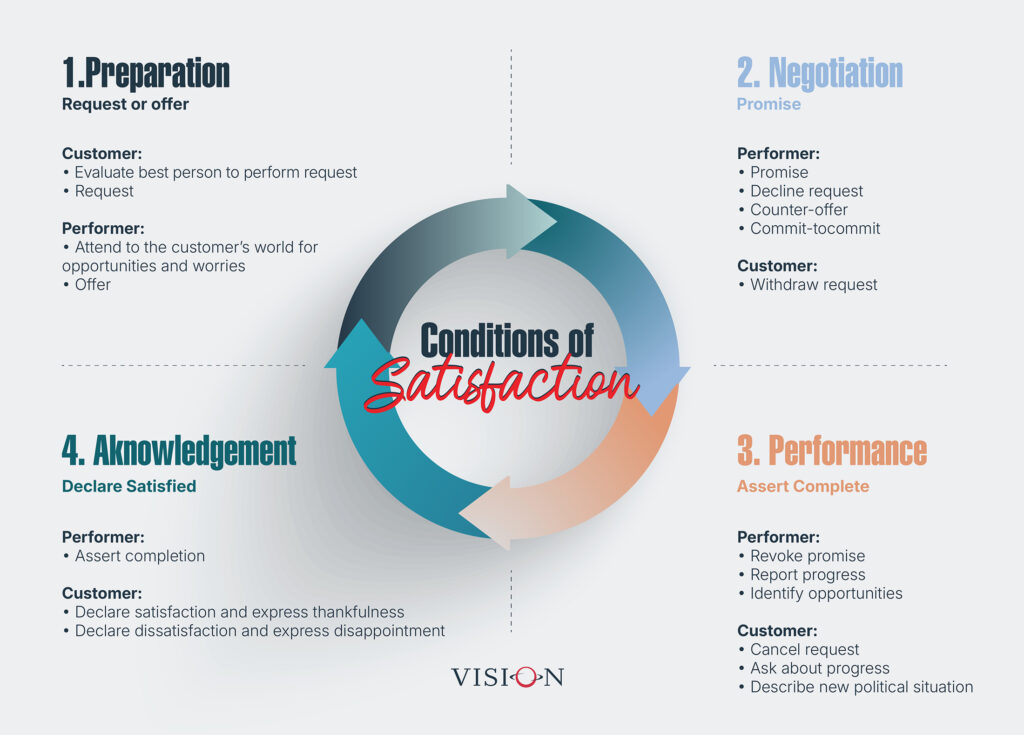The Loop: A Framework for Promise-Making
VISION’s Commitment-based Management™ (CbM) methodology comes from a set of philosophical practices which recognise that work is not simply as a set of tasks, but as a series of commitments people make to one another. Work happens when individuals take responsibility, make promises, and build trust, and the success or failure of that work is heavily dependent on those conversations being managed well.
VISION has developed a variety of tools and approaches for introducing CbM practices to organisation. ‘The Loop’, a framework for assessing the promises people make to each other is a tool we often use to help clients begin to observe promises differently.
Why Promises Matter
Every professional discipline develops its own way of describing how work in an organisation happens. Engineers describe their process in terms of materials being moved and transformed. Programmers describe information. Accountants describe money. Training to work in those professions requires familiarising oneself with the tried and tested approaches that the industry has developed to organise work – such as Lean manufacturing, or Agile software development to reduce waste and improve the quality and predictability of outcomes.
In my career I have reviewed many versions of process flows intended to describe how work happens – documentation which often bares very little resemblance to the reality of how work happens on the ground. Of course, the reason for this is that the work is not delivered by a process but by people, who are far more unpredictable than a packet of information in a computer or euros and cents on a balance sheet. Over time, organisations accumulate various checks and balances to their processes in an attempt to improve predictability – layers of bureaucracy adding time and cost to getting work done with often dubious returns.
What is typically neglected in these processes are the skills of promise-making and promise-keeping. Promises are not about materials or information or money. They are about people making requests of each other, listening to one another’s concerns, and trusting each other’s commitment to a shared future together. This is a sophisticated business, yet people are generally expected to pick up these skills ‘on the fly’ through experience or natural aptitude.
The Loop
The Loop a simple framework VISION uses to develop and assess the promises made in an organisation. By applying this framework to the various processes in the organisation we can build a picture of how the key conversations are contributing or detracting from the work of the business.
We like to bring clients through The Loop within the first two or three weeks of a project to introduce them to the idea of promise-making as a skill. In this framework, there are four distinct phases involving a customer making a request and a performer delivering the work.

The Loop
Preparation: Listening for concerns
This is a listening exercise involving a careful conversation between the Customer and Performer, allowing both parties the opportunity to share their concerns and ambitions.
One feature of the preparation phase is the development of new listening skills. In particular people need to work hard to ‘listening for difference’. Many people’s natural reaction when they hear a common request is to process what is being said in ways that resonate with previous experiences of a similar request. They fail to recognise the subtle, yet critical, differences in what has driven the request. As a result, people feel that they are not being listened to and are treated as ‘a case’ or ‘an account’.
Negotiation: Make the deal
Both parties work together to refine all the details of the offers and/or counter-offers. The object of this phase is to agree as the Conditions of Satisfaction. That is, to the greatest extent possible, how can we describe:
- What will be done?
- By when?
- To what standard?
- What are the objections and obstacles to be removed?
- What are the critical points for the Customer?
When the Conditions of Satisfaction are agreed, and the Customer accepts the Performer’s promise, the negotiation is done.
Delivery: Do the work
Commitments have been made with everyone agreed on what they need to do to deliver the overall commitment. Now is the time to get the job done.
The Performer coordinates the work, keeping the Customer up-to-date on progress, problems and solutions. One certainty is things will change. It is how agile we are in reacting to these changes that will determine our success.
Check for Satisfaction: How did it go?
The work has been done and the request has been delivered. Now is the time to review the work and find out from the Customer:
- Did we deliver on our commitment?
- Were there any problems?
- What could have been done differently?
- Is the Customer completely satisfied with everything that has been completed?
We take learnings from this quadrant into the next round of the loop to improve the experience and outcomes.
What I’ve Learned from Using the Loop
I am approaching ten years of using The Loop to some degree or other every day. Here is some of what I’ve learned in that time:
- The most common missing element in a commitment is time – by when does this need to be delivered? Next time you are in a meeting observe how many promises people make to each other without saying when it will be delivered. Now consider how much miscoordination that missing conversation might lead to.
- Most people in ambitious organisations tend to want to live in Quadrant 3 as much as possible – moving to action straight away. However, the most effective people I’ve worked with spend a lot of time in Quadrant 1 – taking the time to understand the concerns, values, and ambitions of another person. People who do this well make more meaningful promises and develop trust quicker than people who jump straight into action.
- The Loop is a dance, not a set of directions. Do not make the mistake of marrying yourself to past conversations whilst the world around you changes. Performer and Customer need to stay in touch throughout the process and be ready to move back and forwards in the Loop as conditions dictate.
- Promise-making for the sake of promise-keeping is tedious. People need to be connected to a bigger vision – what does the organisation deliver to its customers, and why does it matter? How do I marry the goals of the business to the dreams of the people working in it? The Loop is not a substitute for these conversations. Use promises to elevate your team’s sense of responsibility, not to relegate their work to a series of tasks.
- In the same vein, do not make the fatal mistake of turning managers into watchmen tracking promises met and broken. This approach is guaranteed produce teams devoid of ambition and excitement. People inevitably will only promise what they are sure they can achieve, and – even worse – will develop techniques for dodging promises that are challenging. I take 70% success as a good approximate which indicates a person is pushing themselves to deliver a high performance, and design promises with this in mind.
Using the Loop to Make Work Meaningful
In VISION’s world, making work meaningful means connecting teams to the network of promises they make to each other to provide a service for customers – making sure the lights stay on, or a patient gets cared for, or water stays clean.
Ultimately, The Loop is not about rigid compliance or perfection in execution. It’s about nurturing a culture where promises matter. It works at its best when it helps teams grow a shared sense of purpose. And when people are connected to that purpose, they work with greater care, creativity, and collaboration. That is the real power of promise-making: it turns work into something more human, and ultimately, more meaningful.
Ready to turn promises into performance?
If The Loop sounds like the kind of shift your organisation needs – where teams listen deeply, negotiate clearly, deliver reliably, and learn continuously – we’d love to explore it with you. It’s not theory. It’s a proven approach that can boost productivity by 10–20%—and transform how people work together.
Want to experience the impact for yourself?
Email info@vision.com and we’ll give you free access to our Introduction to Commitment-Based Management for Efficiency, Effectiveness and Agility online course from the VISION Academy (valued at £119). It’s a practical first taste of what’s possible and how promise-based work can transform your organisation.
